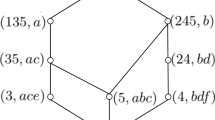Abstract
The theory of concept lattices is an efficient tool for knowledge representation and knowledge discovery, and is applied to many fields successfully. One focus of knowledge discovery is knowledge reduction. Based on the reduction theory of classical formal context, this paper proposes the definition of decision formal context and its reduction theory, which extends the reduction theory of concept lattices. In this paper, strong consistence and weak consistence of decision formal context are defined respectively. For strongly consistent decision formal context, the judgment theorems of consistent sets are examined, and approaches to reduction are given. For weakly consistent decision formal context, implication mapping is defined, and its reduction is studied. Finally, the relation between reducts of weakly consistent decision formal context and reducts of implication mapping is discussed.
Similar content being viewed by others
References
Wille R. Restructuring lattice theory: An approach based on hierarchies of concepts. In: Rival I, ed. Ordered Sets. Reidel: Dordrecht-Boston, 1982. 445–470
Oosthuizen G D. The application of concept lattice to machine learning. Technical Report. University of Pretoria, South Africa, 1996
Ho T B. Incremental conceptual clustering in the framework of Galois lattice. In: Lu H, Motoda H, Liu H, eds. KDD: Techniques and Applications. Singapore: World Scientific, 1997. 49–64
Kent R E, Bowman C M. Digital libraries, conceptual knowledge systems and the nebula interface. Technical Report. University of Arkansas, 1995
Corbett D, Burrow A L. Knowledge reuse in SEED exploiting conceptual graphs. In: Eklund P W, Ellis G, Mann G, eds. Proceeding of 4th International Conference on Conceptual Graphs (ICCS’96). Heidelberg: Springer, 1996. 56–60
Sutton A, Maletic J I. Recovering UML class models from C++: a detailed explanation. Inf Software Tech, 2007, 49(3): 212–229
Siff M, Reps T. Identifying modules via concept analysis. In: Harrold M J, Visaggio G, eds. Proceedings of International Conference on Software Maintenance. Washington, DC: IEEE Computer Society, 1997. 170–179
Ho T B. An approach to concept formation based on formal concept analysis. IEICE Trans Inf Syst, 1995, E782D(5): 553–559
Godin R. Incremental concept formation algorithm based on Galois (concept) lattices. Comp Intell, 1995, 11(2): 246–267
Yao Y Y. Concept lattices in rough set theory. In: Dick S, Kurgan L, Pedrycz W, et al. eds. Proceedings of 2004 Annual Meeting of the North American Fuzzy Information Processing Society (NAFIPS 2004). Washington, DC: IEEE Computer Society, 2004. 796–801
Saquer J, Deogun J S. Concept approximations based on rough sets and similarity measures. Appl Math Comp Sci, 2001, 11(3): 655–674
Tonella P. Using a concept lattice of decomposition slices for program understanding and impact analysis. IEEE Trans Software Eng, 2003, 29(6): 495–509
Grigoriev P A, Yevtushenko S A. Elements of an agile discovery environment. In: Grieser G, Tanaka Y, Yamamoto A, eds. Proceeding of 6th International Conference on Discovery Science (DS 2003). Berlin: Springer, 2003. 309–316
Gatzemeier F H, Meyer O. Text schema mining using graphs and formal concept analysis. In: Priss U, Corbett D, Angelova G, eds. Conceptual Structures — Integration and Interfaces (ICCS 2002). Berlin: Springer, 2002. 107–121
Zhang W X, Wei L, Qi J J. Attribute reduction theory and approach to concept lattice. Sci China Ser F-Inf Sci, 2005, 48(6): 713–726
Zhang W X, Qiu G F. Uncertain Decision Making Based on Rough Sets (in Chinese). Peking: Tsinghua University Press, 2005
Ganter B, Wille R. Formal Concept Analysis, Mathematical Foundations. Berlin: Springer, 1999
Wei L. Reduction theory and approach to rough set and concept lattice. Dissertation for the Doctoral Degree (in Chinese). Xi’an: Xi’an Jiaotong University, 2005
Author information
Authors and Affiliations
Corresponding author
Additional information
Supported by the National 973 Program of China (Grant No. 2002CB312200), the National Natural Science Foundation of China (Grant Nos. 60703117, 60433010 and 60673096), and the Doctor Research Fund of Northwest University in China
Rights and permissions
About this article
Cite this article
Wei, L., Qi, J. & Zhang, W. Attribute reduction theory of concept lattice based on decision formal contexts. Sci. China Ser. F-Inf. Sci. 51, 910–923 (2008). https://doi.org/10.1007/s11432-008-0067-4
Received:
Accepted:
Published:
Issue Date:
DOI: https://doi.org/10.1007/s11432-008-0067-4




